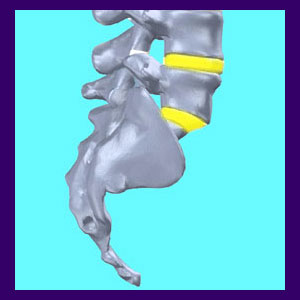
Coccyx pain is a big problem, since it can prevent many of the normal physical activities we all take for granted, such as sitting or even sleeping. Pain in the tailbone is a physically and mentally limiting condition which can drastically reduce mobility, comfort and functionality. The medical term for this general symptom is coccydynia, but most patients simply call this troublesome condition a real pain in their butt; literally.
As an adult, I never had tailbone pain. However, as a child, I clearly remember hurting my tailbone slipping in the bathtub and having soreness there for what seemed like an eternity. I have tremendous sympathy for anyone who has chronic coccyx symptoms and double this sympathetic feeling if they must sit in order to work. Speaking of a fate too horrible to bear.
For such a small and completely useless structure, the coccyx can cause so much agony. It is a wonder that evolution has not gotten rid of it 100% by now. Maybe some generation far in the future will not have to deal with this condition anymore, if this vestigial tail finally goes missing from the human anatomy.
Causes of Coccyx Pain
There are three common scenarios that cause the vast majority of all tailbone pain syndromes:
Back injury can damage the tailbone mildly or severely. Falls are the most common cause of tailbone injury. Falling while going down stairs, getting in or out of the bathtub or sitting down are the most likely to generate the proper angle to fracture or bruise the coccyx. A bruise can be very painful, but will usually resolve without any treatment in a matter of weeks. A fracture might take months to fully heal and can cause pain for an extended time period. Fractures which separate and migrate can be truly difficult to manage and may require open reduction (surgery), in order to fully resolve. Any suspected fracture should be examined by a qualified doctor.
Pregnancy back pain is another cause of coccyx injury, but in this case the occurrence is less obvious. When giving birth, the woman’s coccyx can sometimes be injured by the baby’s head, as the child travels through the birth canal. Due to the pain of childbirth, this additional pain is rarely noticed until several days after the birth. Any unexplained postpartum tailbone pain should be reported to your doctor at once.
Psychosomatic back pain is a very common form of chronic back ache, regardless of where symptoms are experienced. The coccyx is a typical region for a patient to develop a chronic psychosomatic pain syndrome. Patients who have suffered a previous injury to their coccyx are especially susceptible to this phenomenon. It is important to recognize that physical injuries will almost always heal with time and/or treatment. Long-term treatment resistant back pain is rarely caused by a purely anatomical condition and may simply be the result of a symptomatic psychogenic syndrome.
Painful Coccyx Topics
Even with a relatively narrow topic, like tailbone pain, there are important considerations to keep in mind when seeking information. We offer the following discussions on the subject to assist with your research efforts:
Pain in the tailbone might originate from injury, degeneration or idiopathic reasons.
Coccyx pain relief may be enacted through nonsurgical or invasive care plans.
Coccydynia is the technical medical term for tailbone discomfort. However, there are different explanations for why the tailbone might become painful. Be sure to learn all about improving diagnostic accuracy before seeking treatment.
A fractured coccyx and a broken tailbone describe the same condition, but coccyx breaks come in many severities, including hairline, simple and complex fracture types.
Coccyx surgery should be the last line of treatment for chronic and unresponsive tailbone discomfort. Surgery comes in several common forms, each used for a specific purpose.
Coccyx pain responds very well to our proven Cure Back Pain Forever Program. You can find immediate relief 24 hours a day from anywhere in the world with our complete online peer-acclaimed program.
Coccyx Pain Effects
Tailbone pain is commonly a chronic concern which can last for months or even years. Due to the sensitive nature of the coccyx region, patients develop a diversity of prohibited behaviors due to their painful symptoms. Patients often have trouble sitting or lying down and might even develop insomnia in response to the inability to find a comfortable sleeping position.
A painful coccyx is especially serious for people who must sit for long periods of time. Hours of seated activity with a painful tailbone can seem like an eternity in Hell on Earth. Donut pillows can only help so much.
Tips for Coccyx Pain Relief
Coccydynia is a condition which is on the rise among patients. The back pain industry loves tailbone pain, since the treatments can be so incredibly profitable. Most patients with chronic coccyx symptoms spend many months enduring conservative back pain treatments until some acquiesce to surgery which removes the entire coccyx. This procedure is expensive and quite easy for the surgeon to perform. All told, every patient with long-term tailbone pain is a cash cow for doctors who specialize in treating coccyx-related pain syndromes.
Before undergoing any drastic medical treatment for unexplained coccyx pain, make sure that you are not suffering from a mindbody syndrome. Knowledge therapy will help to separate the potential psychological causes from the physical conditions with relative ease. Research the topic of coccyx pain thoroughly and I am sure you will discover that this is one of the most common forms of idiopathic back pain.
Someday, doctors will realize that some of these idiopathic conditions are actually often due to the complex interaction between the mind and the body. Until then, you must be vigilant and play an active role in your own coccyx symptom treatment or else you too might find yourself misdiagnosed and undergoing unnecessary surgery for a condition which can possibly be resolved without the risk or suffering of an operation.





